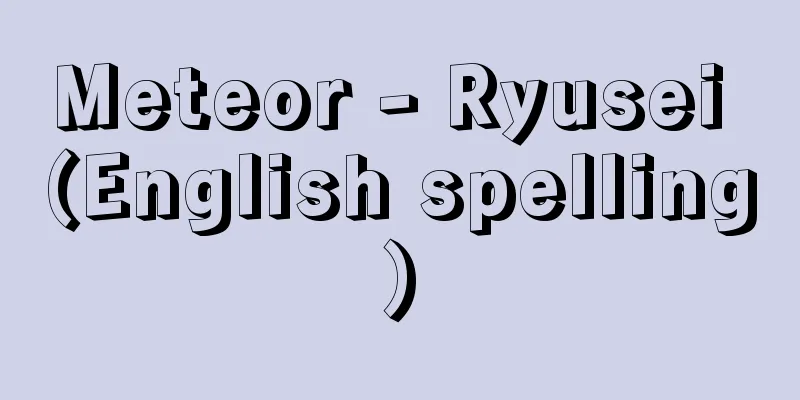Meteor - Ryusei (English spelling)

|
A shooting star is a light that appears suddenly in the night sky with a trailing tail. It is a tiny celestial body moving within the solar system that crashes into the Earth, collides with the upper atmosphere, heats up, and shines. All of these celestial bodies revolve around the Sun at speeds of several tens of kilometers per second, and although there are differences depending on the direction of impact, such as head-on or rear-end collisions with the Earth, they collide with the Earth at speeds of around 10 kilometers per second for the slowest and 70 kilometers per second for the fastest. Therefore, the often-used expression that "they are falling due to the gravitational force of the Earth" is incorrect. Meteoroids collide with the Earth's upper atmosphere, generate heat, and evaporate, causing the atmosphere in front of them to turn into a plasma state and appear to glow, but then eventually disappear. Generally, fast meteoroids glow in the high sky, while slow ones glow in the low sky, but most shine at altitudes of around 110 to 80 kilometers above the ground. Particularly bright meteors are called fireballs, and many of them reach altitudes of less than 50 kilometers. Rarely, fireballs can be as bright as the full moon. Conversely, there are also meteors that are so faint they can only be seen with a telescope, and the fainter they are, the more numerous they are. Bright meteors often leave behind streaks of light after they pass, called meteor trails, but most disappear within a few seconds. Microbodies are meteors bright enough to be seen with the naked eye, weighing anywhere from a few milligrams to a few tens of grams, with a low density of less than 1, and are thought to be made up of fairly coarse icy matter. The chemical composition of meteoroids is not fully understood, although elements such as calcium, sodium, magnesium, iron, and silicon have been detected from their spectra. Although several meteors can usually be seen per hour, the number visible in any one location is limited. It is estimated that tens of millions of meteors visible to the naked eye fall on the entire surface of the Earth every day. Meteor showers are a type of event where a particularly large number of meteors can be seen at the same time every year. These are events where the orbits of meteoroids in a given direction intersect with the orbit of the Earth, and the meteoroids enter the Earth from this intersection. Ordinary meteors that do not belong to these meteor showers are called sporadic meteors. During the active period of a meteor shower, dozens of meteors can be seen every hour, making them easy to see, but it is thought that sporadic meteors make up the majority of all meteors. By photographing the same meteor simultaneously from two locations on Earth more than a few kilometers apart, its actual path through the atmosphere can be determined and its speed can also be measured in detail. From this data, it is possible to calculate the orbit that the meteoroid took around the Sun before it collided with the Earth. In the past, many meteors had hyperbolic orbits with respect to the Sun and were thought to have originated outside the solar system, but subsequent precise observations have revealed that almost all of them have elliptical orbits and are celestial bodies that belong to the solar system. In recent years, in addition to photographic observations, radio observations have also become popular, making use of the fact that the columns of plasma created by meteors reflect radio waves, and not only are the paths and speeds of meteors being determined, but meteor showers that are active during the daytime, when photographic and visual observations are impossible, can also be captured. The Italian Schiaparelli was the first to point out that the orbits of meteor showers are similar to those of comets. In 1866, he studied the orbit of the Perseid meteor shower and found that it was similar to the orbit of the "3rd Comet of 1862". Around the same time, Comet Bila, which orbited every six and a half years, split into two and disappeared in 1859. However, on November 27, 1872, an enormous meteor shower of 3,000 meteors per hour appeared from the direction of Andromeda. A meteor shower is a large meteor shower in which thousands or tens of thousands of meteors appear per hour. The fact that the orbit of the Andromedid meteor shower was very similar to that of Comet Bila strongly suggested the relationship between meteors and comets. It is well known that whenever a comet returns close to the Sun, numerous particles are released as the gas evaporates, as can be seen from the tails of comets, and it is believed that the dust particles thus expelled gradually disperse along their orbits and form meteor showers. Examples of this are the Leonids meteor shower associated with Comet Tempel, which has a period of 33 years, which produced great meteor showers in 1799, 1833, 1866, and 1966, and Comet Giacobini, which has a period of 6.5 years, which produced great meteor showers in 1933 and 1946. In these relatively recent meteor showers, dust particles are thought to be concentrated only in the vicinity of the parent comet. Among the meteors whose orbits have been determined through photographic observation, some have been found to have orbits more similar to those of asteroids than comets. These meteoroids have a relatively high density and are thought to have properties similar to those of meteorites. [Sadao Murayama] [Reference items] | | |Source: Shogakukan Encyclopedia Nipponica About Encyclopedia Nipponica Information | Legend |
|
夜空に、突然、尾を引いて飛ぶように見える光体で、流れ星ともいう。これらは太陽系内を運動している微小な天体が地球に突入してきて、上層の大気と衝突し、発熱して輝くものである。 これらの天体は、いずれも秒速数十キロメートルの速度で太陽の周りを公転しており、地球と正面衝突あるいは追突といった突入方向によって差ができるが、遅いもので秒速10キロメートル、速いものでは秒速70キロメートルぐらいの速さで衝突してくる。したがって、しばしば使われる「地球の引力に引かれて落ちてくる」という表現は正しくない。 流星体は、地球の上層大気と衝突、発熱して蒸発し、前面の大気もともにプラズマ状態となって輝いて見えるが、やがて消滅してしまう。一般に速いものは高空で発光し、遅いものは低空で発光するが、多くは地上110キロメートルから80キロメートルぐらいの高さで輝く。 とくに明るい流星を火球とよび、50キロメートル以下の高さまでくるものも多い。まれには満月のように明るい火球もある。反対に望遠鏡でなければ認められないほど微光の流星もあって、暗いものほどその数は多くなる。明るい流星ではしばしば通過のあとに光の筋(すじ)を残すことがあって流星痕(こん)とよばれるが、多くは数秒程度で消滅する。 微小天体は、肉眼で見えるぐらいの明るさの流星となるもので、数ミリグラムから数十グラム程度の小さなもので、密度も小さく1以下のものが多く、かなり粗い氷質のものが多いと考えられている。流星体の化学組成については、そのスペクトルからカルシウム、ナトリウム、マグネシウム、鉄、ケイ素などの元素が検出されているが、十分にはわかっていない。 流星は通常1時間に数個は見られるが、一地点で見られる流星は限られている。地球の全表面では、肉眼で認められるぐらいのものだけで、毎日数千万個の流星が降り注いでいると見積もられている。 毎年、同じ時期に、とくに多くの流星が見られるのが流星群である。これは、流星体の群が回っている決まった軌道が地球の軌道と交差しているために、その交点で決まった方向から地球に突入してくるものである。 これら流星群に属さない一般の流星を散在流星という。流星群の活動期には毎時数十個という多くの流星が見られるので目につきやすいが、流星全体では散在流星のほうが多くを占めていると考えられている。 地球上で数キロメートル以上離れた二地点から同一の流星を同時に写真観測することによってその大気中での実経路が求められ、また速度も詳しく測定できる。これらのデータから流星体が地球に衝突する以前に太陽の周りを公転していた軌道を算出することができる。かつては、流星の多くが太陽に対して双曲線の軌道をもち、太陽系外に起源をもつと考えられたこともあるが、その後の精密観測によってほとんどすべてが楕円(だえん)軌道を回っており、太陽系に属する天体であることが判明した。近年は写真観測ばかりでなく、流星によってできるプラズマの柱が電波を反射することを利用した電波観測も盛んに行われて、その経路や速度が求められているばかりか、写真観測、眼視観測が不可能な昼間に活動する流星群もとらえられている。 流星群の軌道が彗星(すいせい)の軌道に類似していることを初めて指摘したのは、イタリアのスキャパレリで、1866年にペルセウス流星群の軌道を研究して、それが「1862年第三彗星」の軌道に似ていることをみいだした。同じころ、6年半ほどの周期で回っていたビーラ彗星が二つに分裂し、1859年には見られなくなったが、1872年11月27日にアンドロメダ座の方向から、毎時3000個ものおびただしい流星雨が出現するという事件がおこった。流星雨というのは、1時間に数千、数万といった流星が現れる流星群の大出現をいうが、このアンドロメダ座流星雨の軌道がビーラ彗星の軌道に酷似していたことも、流星と彗星の関係を強く暗示することになった。 彗星が太陽の近くに回帰するたびに、ガスの蒸発とともに数多くの微粒子が放出されることは、彗星の尾にプラズマの尾と塵(ちり)の尾が見られることからよく知られているが、こうして吐き出された塵粒子がしだいに軌道上に分散して流星群をつくると考えられている。周期33年のテンペル彗星に伴うしし座流星群が、1799年、1833年、1866年、1966年などに大流星雨を出現させたり、周期6年半のジャコビニ彗星が1933年、1946年などに大流星雨を降らせたりしたのはその例で、これら比較的新しい流星群では母彗星の近辺にだけ塵粒子が密集しているものとみられる。 なお、写真観測により軌道が求められた流星のなかには、彗星よりも、むしろ小惑星の軌道に似たものもみいだされている。これらの流星体は密度も比較的大きく、隕石(いんせき)に似た性質のものとみられている。 [村山定男] [参照項目] | | |出典 小学館 日本大百科全書(ニッポニカ)日本大百科全書(ニッポニカ)について 情報 | 凡例 |
<<: Longjing (English spelling)
Recommend
Karaman - Karaman
…1250?-1487. The first capital was Laranda (Karam...
birdie
…An 18-hole course is usually designed with 4 sho...
"The Zauberberg" (English spelling)
…Thomas judged that the introduction of the democ...
Giant midge - Oyurika
...They lay gelatinous egg masses on the water su...
Independence - Dokuritsu
〘Noun〙 ("Ritsu" is the idiomatic pronunc...
Akami
…Some conifers contain resin canals and resin cel...
Uriyangkhatai (English spelling)
Son of Subetei, a military commander of the Mongol...
Rock Seat - Technique
〘 noun 〙 A pedestal for a Buddhist statue, in the ...
Mauremys
...A general term for freshwater turtles that are...
Somatometry
This is a method used to objectively express the p...
Isaburo Kashiwa
...Lyrics by Hisamatsu Issei. Music by Kashiwa Is...
Su Hanchen (English spelling)
A Chinese painter at the Painting Academy in the l...
Kim History
One of the Twenty-Four Histories, an official hist...
Affetti
… In many ways, the reign of Louis XIV saw a cult...
Chuo Line - Chuo Line
The name of the tracks of East Japan Railway Comp...









